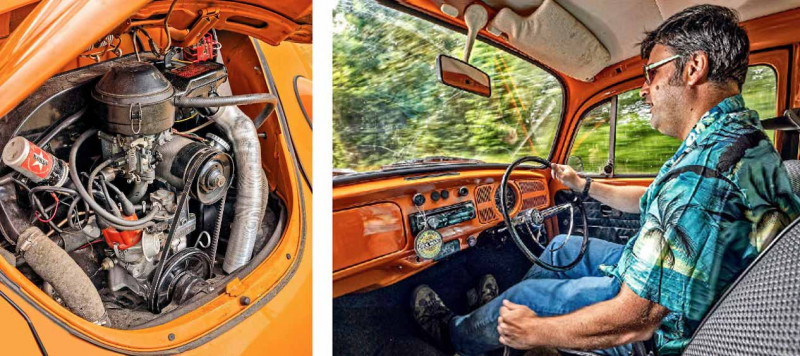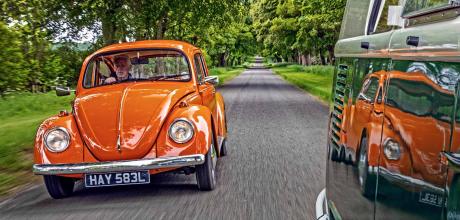1972 Volkswagen 1200 Beetle
It just means ‘People’s Car’, and yet Volkswagen signifies so much more. There’s no shortage of rivals with reliable, cheap utilitarianism at their core, but few have managed to unite counter-culture hippies and surfers with City yuppies and boy racers within their embrace. There’s every chance your first car was a battered Golf – the same thing Prince Michael of Kent uses as a runabout. To investigate this curiously classless appeal, we have gathered six VW icons. There’s the Beetle that began it all, and the Camper that kick-started the ownership cult. The Karmann-Ghia made a glamorous push upmarket, a theme that hit its zenith with the Corrado VR6. And then there’s the Golf GTI, the car that defined the hot hatch. We’ve also included a Lupo GTI, which proved that there was virtue in going back to basics after years of growth. So which will convert us to the cult of VW, and how do you buy your way in? Time to take the wheel and find out.
Before I’ve even taken in this Beetle’s unmistakeable shape, it’s the sheer orangeness that hits me. It dominates my peripheral vision, and continues as I slide my knees under its steering wheel, because the interior of this basic 1200 is full of body-coloured metal too. You could drive it on a wet November day in Skelmersdale and it’d still remind you of Californian sunsets.

‘The distinctive aircooled splutter seems to rise in volume rather than note as you accelerate’
Brilliant Orange says a lot about the root of the Beetle’s appeal and the legacy of VW marketing genius Heinz Nordhoff. By persisting with the same model for decades, VW quickly amortised its production costs and could concentrate on customer service, cutting costs without compromising quality, and expanding things like colour choice and options. ‘We do our thing, you do yours,’ ran VW’s advertising tagline when this car was new, underneath two Beetles – one in black and grey, the other a riot of colour and festooned with accessories.
There’s a precision and tautness to the Beetle’s controls at odds with its laid-back demeanour. The gearchange is slicker and more precise than any rear-engined Porsche would be until the mid-Eighties, and although it isn’t in any way sporty, there’s no slack to this recently rebuilt example’s steering.
It’s slow though. Full tilt is 72mph; the tangerine single-dial dash doesn’t bother with a tacho. You judge the flat-four’s revs through its distinctive aircooled splutter, which doesn’t seem to rise in note but rather in volume as you accelerate. The satisfying precision of the controls has me racing through the gears, then I look down and realise that in fourth, I’m barely over 30mph.
As I pick up speed though, the Beetle surprises with its comfort and refinement. It’s roomier inside than rear-engined rivals like the Hillman Imp and Renault 8, and the way the engine channels its sound away from the passengers while wind noise is kept to an impressive minimum is testament to something altogether more sophisticated from the Beetle’s Thirties origins. Dig beneath the mid-century imagery and at heart it’s an Autobahn streamliner almost like a baby Tatra. What’s most interesting is the way it drives on loose surfaces.
As I negotiate the sandy beach road, I can feel the traction advantage of the engine sitting behind the driven rear wheels, never spinning as it pulls away. It’s easy to see where the idea for the beach buggy came from, and it’s a feeling that adds further to its stability as I accelerate onto faster A-roads. I get the impression it’ll never be fast enough for its lack of aerodynamic downforce to become an issue. Decent brakes – front discs from 1967 – add to that sense of security too. It’s confidence-inspiring. The market for Beetles is heavily dependent on year and body style; the good news is that this leaves something for every budget. Early split-screen cars and their 1953-1958 oval-window successors fetch up to £30k, but their gutless 1.1-litre engines make them less usable. The 1966-1973 cars combine better visibility and engines that aren’t out of their depth on motorways with an earlier chrome-edged style that retained the original sloping headlights until 1967. These tend to be £6k-£12k depending on condition and engine, the 1500 pipping the 1200.
But a Beetle can be had even cheaper if you’re prepared to go for the least fashionable one – the larger-bodied 1.6-litre 1302S ‘Super Beetle’ that supplemented the 1300/1500 from 1971. Its heavy-handed lines, plastic trim and impact bumpers make it less trendy – though with Beetles such things are relative, they’re all cool – but they can still be found for as little as £2500. Regardless of model, your only real issue is rust, which is easily addressed given simple metal pressings and separate-chassis construction. It’s also the most numerous single model of car ever made, with Brazilian production ending in 2006, so Beetle parts availability makes MGB ownership look difficult.
Owning a Volkswagen
Beetle ‘It was actually my son and his friend who got me into aircooled VWs,’ says David Brown, who also owns a bay-window Type 2, which he bought first. ‘Then I was at a friend’s VW dealership and his dad was selling this Beetle, so I bought it in 2016. ‘A lot of Beetles have bits from later cars on them, as did this, but underneath it was a sturdy example of a 1200 so I gradually returned it to its original specification. I had to change the engine though – the original was dropping a lot of oil, but I got a rebuilt one easily enough, which arrived on a pallet from Essex and bolted straight in.
‘It had a big accident with an Audi in 2020 and was put back together by Graeme Millard. Thankfully the insurance money paid for the restoration because the Audi had been driven dangerously, otherwise it would’ve been written off – Graeme had to wrestle the chassis back in line.’
TECHNICAL DATA 1972 Volkswagen 1200 Beetle
- Engine 1192cc horizontally-opposed four-cylinder, ohv, Solex 31 Pict 4 carburettor
- Max Power 40bhp @ 3900rpm
- Max Torque 65lb ft @ 2400rpm
- Transmission Four-speed manual, rear-wheel drive
- Steering Worm and roller
- Suspension Front: independent, torsion bars, trailing arms, telescopic dampers, anti-roll bar. Rear: independent, torsion bars, swing axles, telescopic dampers
- Brakes Drums all round
- Performance Top speed: 72mph
- Acceleration 0-60mph: 29.4sec
- Weight 778kg
- Fuel consumption 33mpg
- Cost new £685
- Classic Cars Price Guide £3500-£12,500
Noisy, but neatly isolated from the cabin Spacious and comfortable for basic car of era.


